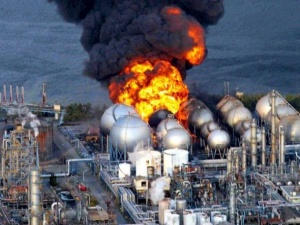Difference between revisions of "Fukushima Daiichi nuclear disaster"
Jump to navigation
Jump to search
(image) |
m (|constitutes=Nuclear disaster) |
||
| (4 intermediate revisions by 3 users not shown) | |||
| Line 4: | Line 4: | ||
|longitude=141°1′57″E | |longitude=141°1′57″E | ||
|locations=Ōkuma, Fukushima, Japan | |locations=Ōkuma, Fukushima, Japan | ||
| + | |constitutes=Nuclear disaster | ||
|image=Fukushima Daiichi nuclear disaster.jpg | |image=Fukushima Daiichi nuclear disaster.jpg | ||
| + | |start=11 March 2011 | ||
| + | |end=11 March 2011 | ||
}} | }} | ||
| + | The '''Fukushima Daiichi nuclear disaster''' began after an earthquake damaged the Fukushima Daiichi nuclear plant, which was later hit by a tsunami. | ||
| + | |||
| + | ==Robots== | ||
| + | Many different types of robots have been used and custom built for the exploration and reconstruction of the site.<ref>https://ndf-forum.com/en/pdf/ref/day2/day2-en_asama.pdf</ref> Some were damaged due to the high radiation.<ref>https://www.computerworld.com/article/3181407/robotics-industry-learns-from-successes-and-failures-at-fukushima.html</ref><ref>https://www.dailymail.co.uk/sciencetech/article-4188146/Radiation-levels-Fukushima-plant-hit-record-high.html</ref> | ||
| + | |||
| + | ==Recent developments== | ||
| + | In [[2017]], radiation levels inside Fukushima Daiichi nuclear reactor No. 2 exceeded 530 sieverts/hour, a number experts have called "unimaginable".<ref>http://www.sciencealert.com/radiation-levels-in-the-fukushima-reactor-have-started-unexpectedly-climbing</ref> | ||
| + | |||
{{SMWDocs}} | {{SMWDocs}} | ||
| + | |||
==References== | ==References== | ||
{{Reflist}} | {{Reflist}} | ||
| − | |||
Latest revision as of 17:25, 29 October 2021
 | |
| Date | 11 March 2011 |
|---|---|
| Location | Ōkuma, Fukushima, Japan |
| Interest of | Yoichi Shimatsu |
The Fukushima Daiichi nuclear disaster began after an earthquake damaged the Fukushima Daiichi nuclear plant, which was later hit by a tsunami.
Robots
Many different types of robots have been used and custom built for the exploration and reconstruction of the site.[1] Some were damaged due to the high radiation.[2][3]
Recent developments
In 2017, radiation levels inside Fukushima Daiichi nuclear reactor No. 2 exceeded 530 sieverts/hour, a number experts have called "unimaginable".[4]
Event
| Event |
|---|
| Fukushima Daiichi nuclear disaster |
Related Documents
| Title | Type | Publication date | Author(s) | Description |
|---|---|---|---|---|
| Document:Deconstructing Nuclear Experts | article | 31 March 2011 | Chris Busby | This article was written just 2-3 weeks after the disaster at Fukushima Daiichi. It is notable for its scathing dismissal of official efforts to play down the seriousness of the radiation health effects of the disaster and in particular the credibility of the so-called experts regularly wheeled out by the commercially-controlled media. |
| Document:Fukushima - Nuclear math in meltdown | article | 16 February 2012 | Gayle Greene | |
| Document:Fukushima and the Battle for Truth | webpage | 27 September 2011 | Paul Zimmerman | |
| Document:Is Fukushima's nuclear nightmare over? Don’t count on it | article | 12 March 2016 | Chris Busby | Update on the developing Fukushima-Daiichi nuclear disaster and a good illustration of BBC use of "Experts" to present and give credibility to outrageous falsehoods in support of the "nothing to see here" propaganda of the nuclear industry. |
Many thanks to our Patrons who cover ~2/3 of our hosting bill. Please join them if you can.
References
- ↑ https://ndf-forum.com/en/pdf/ref/day2/day2-en_asama.pdf
- ↑ https://www.computerworld.com/article/3181407/robotics-industry-learns-from-successes-and-failures-at-fukushima.html
- ↑ https://www.dailymail.co.uk/sciencetech/article-4188146/Radiation-levels-Fukushima-plant-hit-record-high.html
- ↑ http://www.sciencealert.com/radiation-levels-in-the-fukushima-reactor-have-started-unexpectedly-climbing